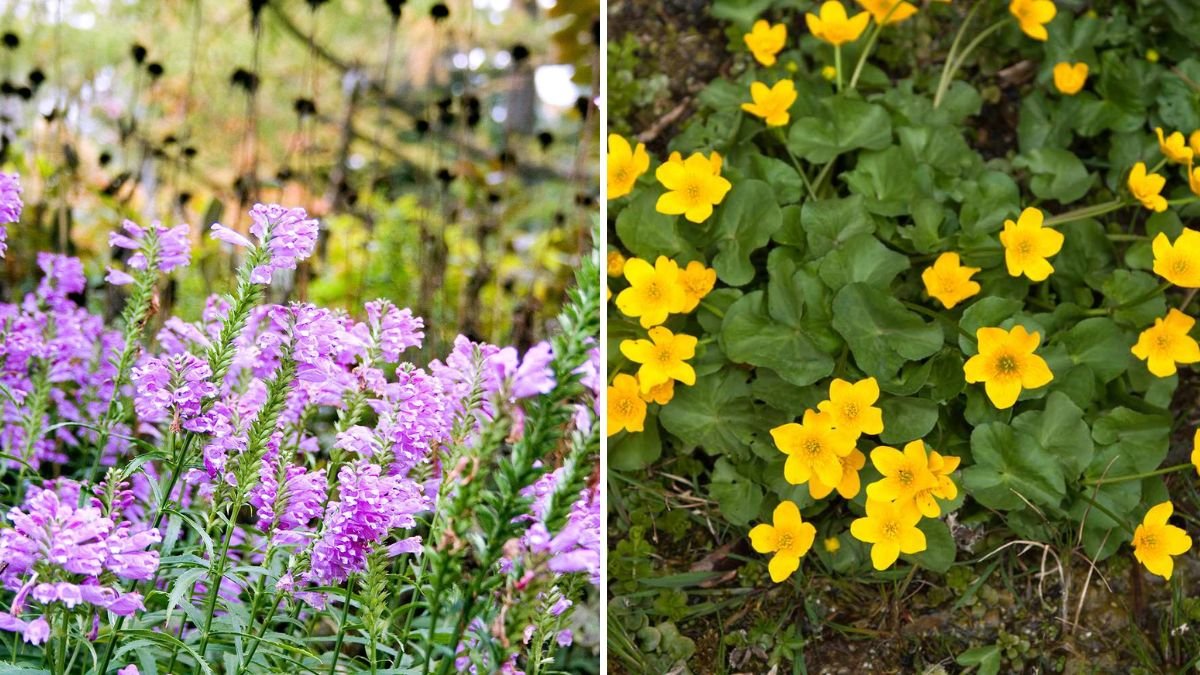Gardens with ponds, streams, or areas of naturally wet soil can be both beautiful and challenging to plant. While many garden plants struggle in consistently moist conditions, certain perennials thrive in wet soil and along pond edges, creating lush, vibrant, and low-maintenance landscapes. These plants not only tolerate moisture but also help stabilize soil, prevent erosion, and enhance habitat for wildlife such as birds, frogs, and pollinators.
This guide highlights eight perennials that flourish in wet soil and pond-edge environments, along with detailed planting and care tips for a thriving waterside garden.
1. Marsh Marigold (Caltha palustris)
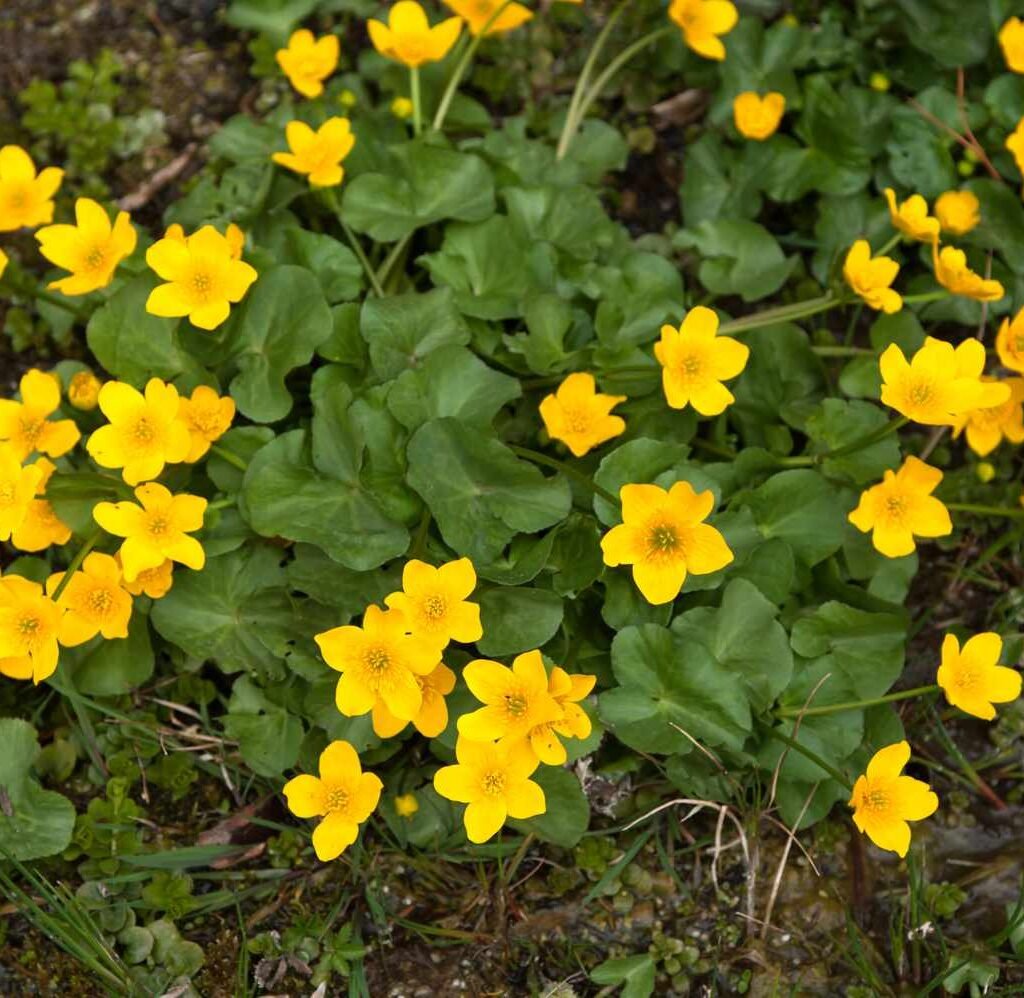
Why It Loves Wet Soil
- Marsh Marigold is a native wetland plant that thrives in consistently moist or even shallow standing water.
- Produces bright yellow flowers in early spring, adding early color to ponds and wet gardens.
- Attracts early pollinators, such as bees emerging in spring.
Care Tips
- Sunlight: Full sun to partial shade.
- Soil: Wet, rich, and consistently moist. Can grow in shallow water along pond edges.
- Maintenance: Low; remove dead foliage in late spring.
- Planting Tip: Plant in clusters to create a bold splash of yellow at the water’s edge.
Bonus: Its vibrant blooms brighten wet areas that are otherwise difficult to plant.
2. Cardinal Flower (Lobelia cardinalis)
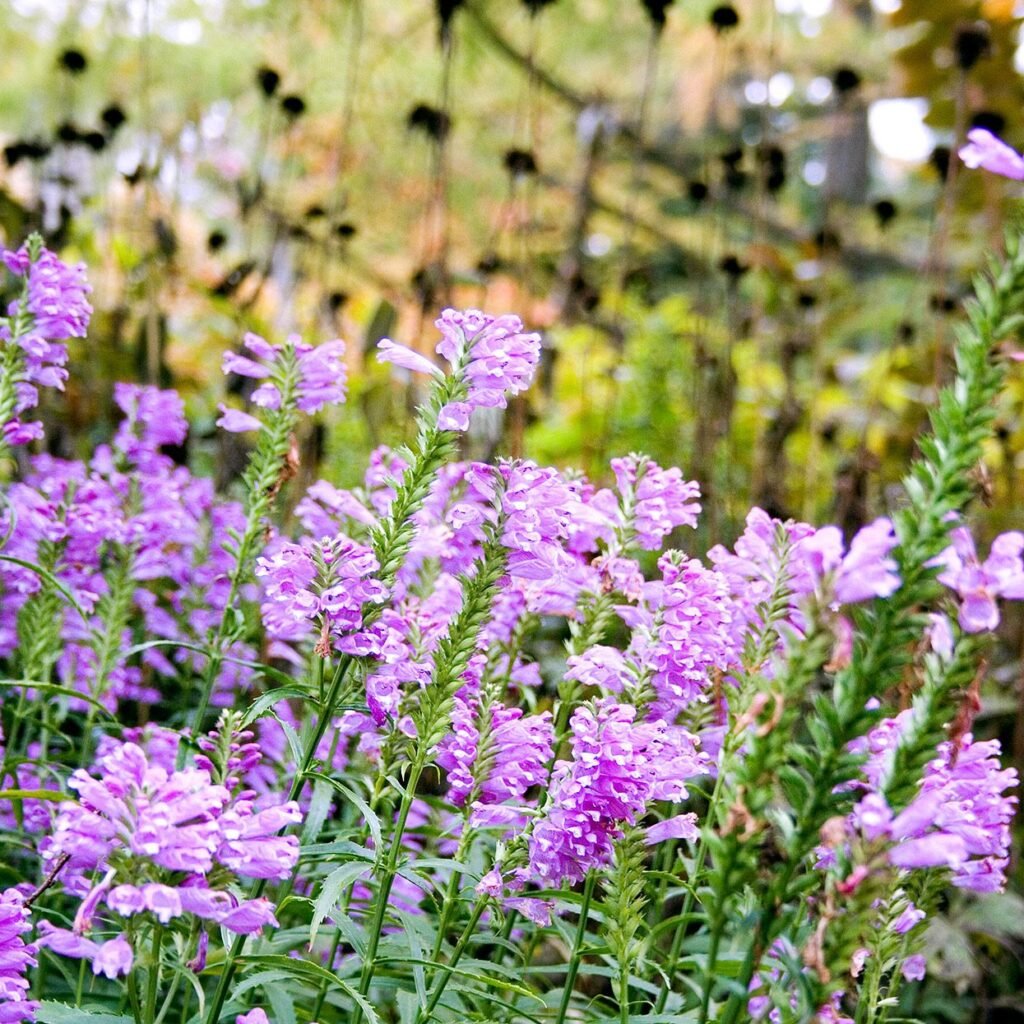
Why It Loves Wet Soil
- Cardinal Flower is a tall, striking perennial with brilliant red blooms that attract hummingbirds and butterflies.
- Thrives in moist soil or shallow water, making it perfect for pond edges.
- Provides vertical interest in wetland garden designs.
Care Tips
- Sunlight: Full sun to partial shade.
- Soil: Rich, consistently moist soil; tolerates shallow water.
- Maintenance: Cut back spent blooms to encourage extended flowering.
- Planting Tip: Pair with ferns or grasses for contrast and texture.
Bonus: Its intense red flowers create a focal point for water gardens.
3. Blue Flag Iris (Iris versicolor)
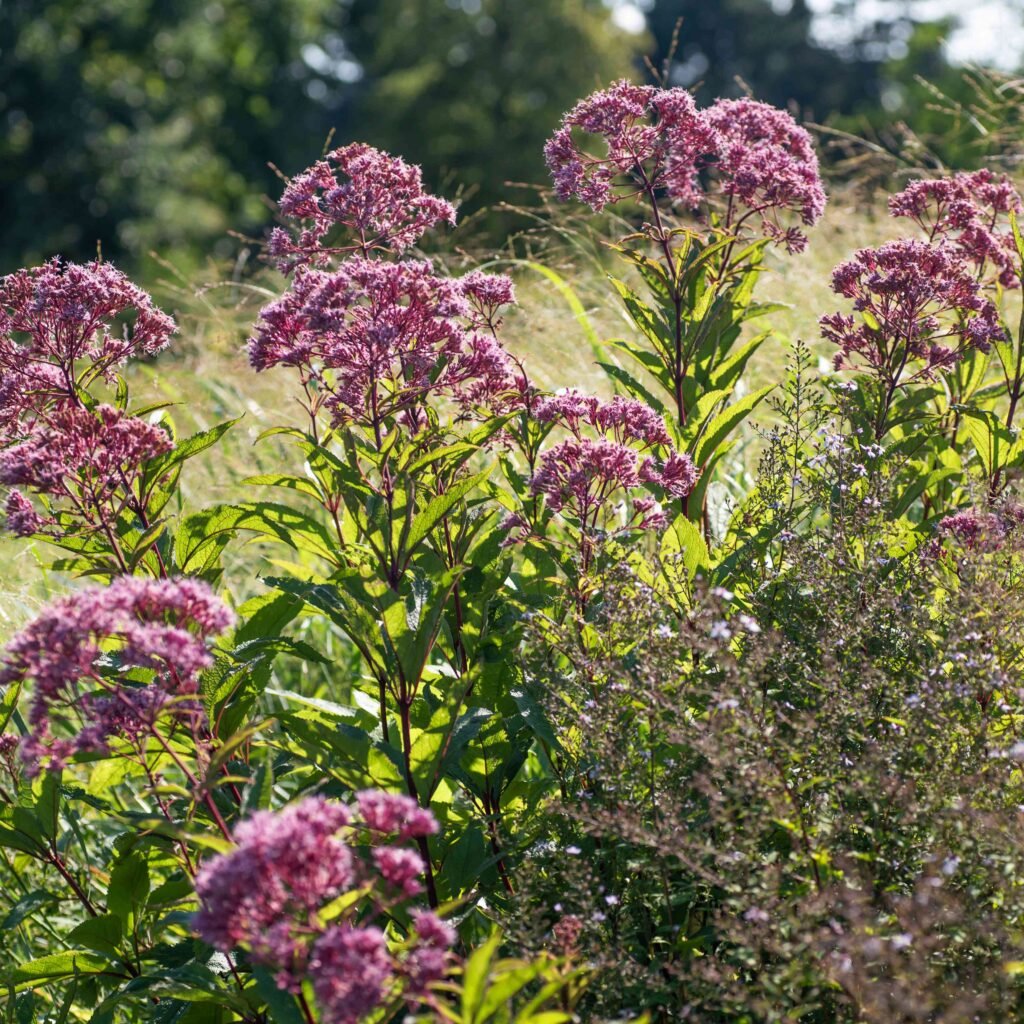
Why It Loves Wet Soil
- Blue Flag Iris is a native iris that thrives along streams, ponds, and marshes.
- Produces vivid blue-violet flowers in late spring, attracting bees and butterflies.
- Spreads easily, forming dense clumps that stabilize pond edges.
Care Tips
- Sunlight: Full sun to partial shade.
- Soil: Moist, acidic to neutral soil; tolerates shallow water.
- Maintenance: Divide clumps every 3–4 years to prevent overcrowding.
- Planting Tip: Plant in groups to maximize visual impact.
Bonus: Its lacy foliage and striking blooms enhance both naturalistic and formal water gardens.
4. Marsh Hibiscus (Hibiscus moscheutos)
Why It Loves Wet Soil
- Marsh Hibiscus produces large, tropical-looking flowers in shades of red, pink, and white.
- Thrives in wet soil, pond margins, and damp meadows.
- Attracts pollinators, including bees and hummingbirds.
Care Tips
- Sunlight: Full sun for abundant blooms.
- Soil: Moist, fertile, well-draining wet soil; tolerates shallow water.
- Maintenance: Cut stems to the ground in late fall; mulch in winter for protection.
- Planting Tip: Ideal as a tall backdrop behind shorter wetland plants.
Bonus: Its dramatic flowers add a tropical touch to wet gardens.
5. Swamp Milkweed (Asclepias incarnata)
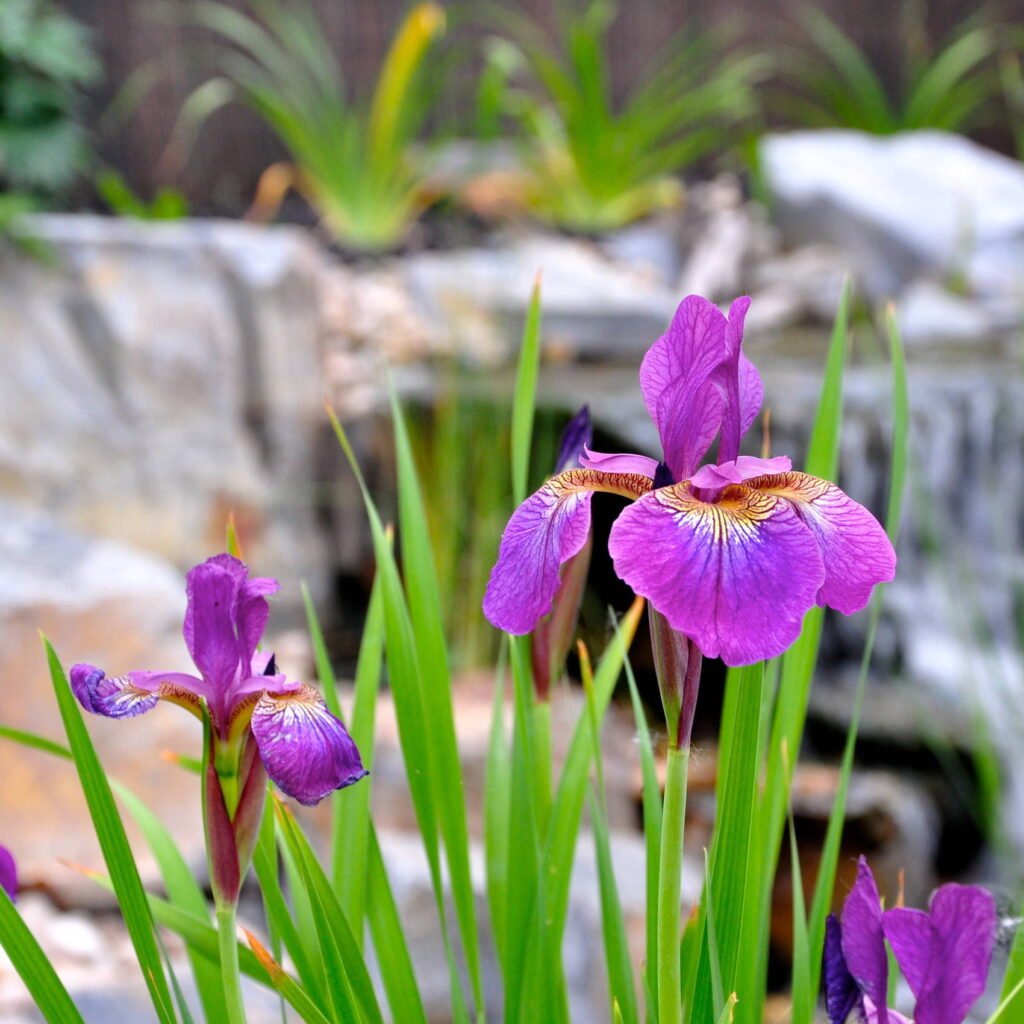
Why It Loves Wet Soil
- Swamp Milkweed is a pollinator-friendly native that thrives in moist soil or near water.
- Produces clusters of pink flowers in summer, attracting butterflies, especially monarchs.
- Supports wildlife and biodiversity in wetland gardens.
Care Tips
- Sunlight: Full sun to partial shade.
- Soil: Moist to wet soil; tolerates occasional shallow flooding.
- Maintenance: Remove spent blooms to encourage longer flowering; cut back in fall.
- Planting Tip: Combine with native grasses for a natural, meadow-like edge.
Bonus: This plant provides nectar and host habitat, supporting pollinator conservation.
6. Joe-Pye Weed (Eutrochium purpureum)
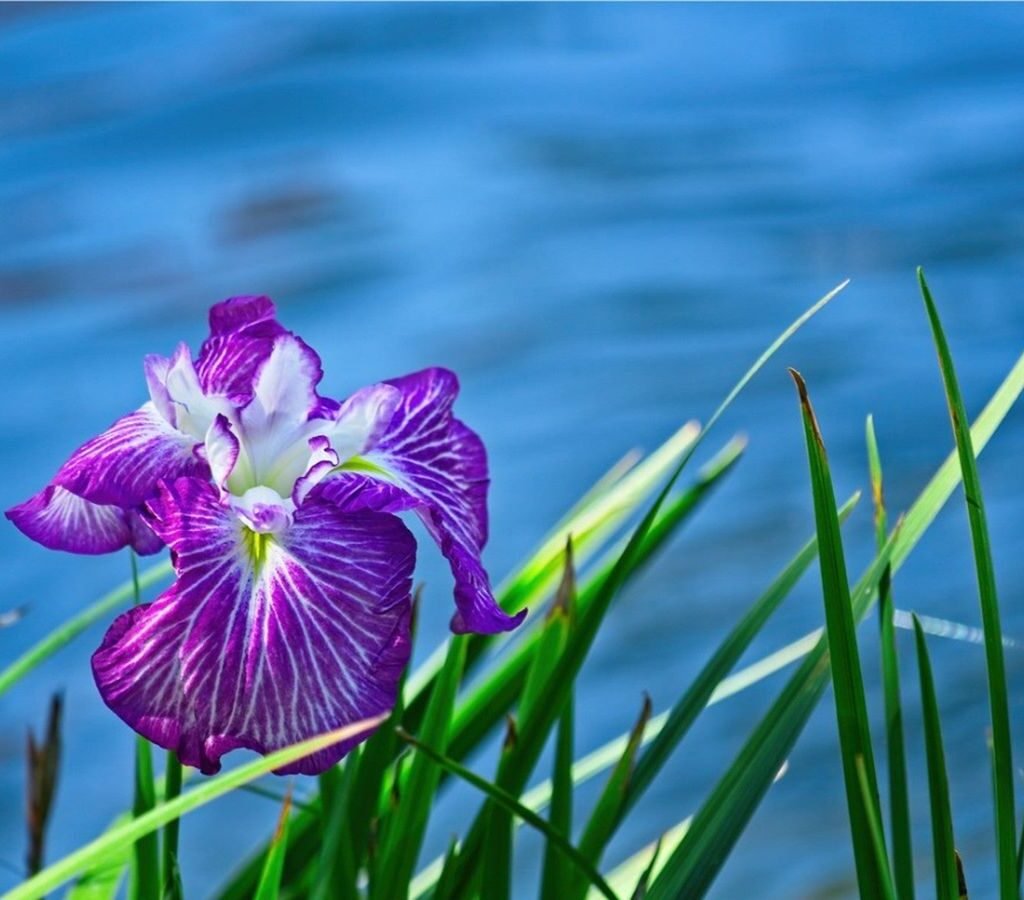
Why It Loves Wet Soil
- Joe-Pye Weed is a tall, sturdy perennial that produces mauve-pink flower clusters in late summer.
- Tolerates wet soil and pond margins, making it ideal for low-lying areas.
- Attracts butterflies, bees, and other pollinators, extending the season of activity in the garden.
Care Tips
- Sunlight: Full sun to partial shade.
- Soil: Moist, fertile soil; tolerates occasional standing water.
- Maintenance: Cut back in late winter or early spring.
- Planting Tip: Use as a vertical accent to create layers in wetland gardens.
Bonus: Its height and color make Joe-Pye Weed a natural backdrop for shorter perennials.
7. Marsh Marigold Cousin: Ligularia (Ligularia dentata)
Why It Loves Wet Soil
- Ligularia is known for its large, bold foliage and bright yellow flowers.
- Thrives in wet, shaded areas, including pond edges and rain gardens.
- Its broad leaves provide dramatic texture and visual contrast with smaller flowers.
Care Tips
- Sunlight: Partial shade to full shade.
- Soil: Moist, humus-rich soil; keep consistently damp.
- Maintenance: Remove spent flower stalks; divide every 3–4 years.
- Planting Tip: Combine with ferns or hostas for moisture-loving shade gardens.
Bonus: Ligularia adds bold foliage interest, even when not in bloom.
8. Siberian Iris (Iris sibirica)
Why It Loves Wet Soil
- Siberian Iris produces slender, elegant flowers in shades of blue, purple, or white.
- Tolerates wet soil and occasional flooding, making it perfect for ponds and streams.
- Forms dense clumps of grass-like foliage, stabilizing edges and preventing erosion.
Care Tips
- Sunlight: Full sun to partial shade.
- Soil: Moist, fertile, well-draining soil; tolerates standing water.
- Maintenance: Divide clumps every 3–4 years to maintain vigor.
- Planting Tip: Plant in clusters for a mass of graceful blooms along water edges.
Bonus: Its slender form and elegant blooms complement bolder wetland plants.
General Tips for Planting Perennials in Wet Soil and Pond Edges
- Group Plants by Moisture Preference: Ensure plants with similar water requirements are planted together for optimal growth.
- Provide Layers: Combine tall perennials like Joe-Pye Weed with mid-height plants like Cardinal Flower and low groundcovers for visual depth.
- Prevent Erosion: Dense plantings stabilize pond edges and reduce soil loss during heavy rains.
- Encourage Wildlife: Include pollinator-friendly plants such as Swamp Milkweed and Blue Flag Iris to attract butterflies, bees, and birds.
- Maintain Soil Health: Mulch around roots to retain moisture and reduce weeds.
- Regular Pruning: Remove dead foliage and spent flowers to maintain plant health and appearance.
Conclusion: Create a Lush Waterside Garden
Gardens with wet soil or ponds can be vibrant, wildlife-friendly spaces when planted with the right perennials. By including Marsh Marigold, Cardinal Flower, Blue Flag Iris, Marsh Hibiscus, Swamp Milkweed, Joe-Pye Weed, Ligularia, and Siberian Iris, gardeners can enjoy bold colors, diverse textures, and year-round beauty along pond edges.
These moisture-loving perennials not only enhance the aesthetic appeal of wet garden areas but also support local ecosystems, providing nectar, shelter, and habitat for pollinators and aquatic life.
With proper planting, spacing, and care, wet-soil gardens can thrive naturally, creating a peaceful, picturesque landscape that combines ornamental beauty and ecological benefits. These perennials make pond edges and damp garden areas a focal point of color and life, ensuring your waterside garden remains captivating season after season.
